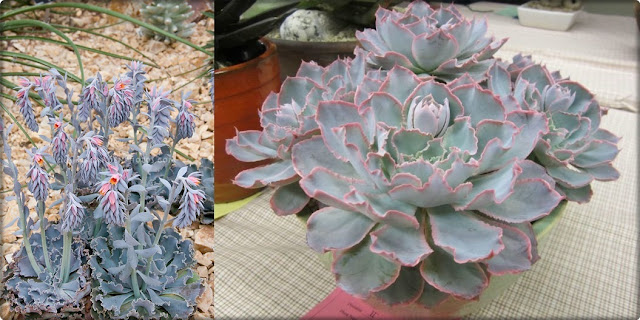Echeveria shaviana (Mexican Hens) is an evergreen succulent with short-stemmed rosettes, up to 8 in. wide (20 cm), packed with fifty or more, fleshy, smooth, very wavy crinkled, blue-gray leaves. Thin and delicate, the frilly leaves take on a pink blush in strong light. In summer, it sends up 1ft. tall (30 cm) stems which bear flowers arranged to one side of the stalk, pink outside and yellow inside. This Echeveria offsets readily and is a great choice for rock gardens, green roofs or containers.
How to Grow and Care
Most of the common Echeveria species are not complicated succulents to grow, provided you follow a few basic rules. First, be careful never to let water sit in the rosette as it can cause rot or fungal diseases that will kill the plant. Additionally, remove dead leaves from the bottom of the plant as it grows. These dead leaves provide a haven for pests and Echeverias are susceptible to mealy bugs. As with all succulents, careful watering habits and plenty of light will help ensure success.
Light: It thrives best in full sun to light shade. In indoor an east or west-facing window where they receive four to six hours of sunlight is ideal.
Soil: It grows well in a well-drained succulent mix, with an ideal pH around 6.0 (slightly acidic) or an equal part sharp sand with all-purpose potting mix.
Water: Water Echeveria plant regularly during the summer and spring. keep the soil evenly moist but not soggy. You can allow the topsoil to become slightly dry between each watering. Reduce water in the winter.
Temperature: It prefers an average summer temperature of 65ºF / 18ºC – 70ºF / 21ºC. In winter, cool to 50ºF / 10ºC.
Fertilizer: Fertilize with a controlled-release fertilizer at the beginning of the season or weekly with a weak liquid solution. Use a balanced 20-20-20 fertilizer at 1/4 strength on mature plants, and a fertilizer with less nitrogen on young plants.
Origin: Echeveria shaviana is native to the mountainous areas in northern Mexico.
Re-potting: Re-pot as needed, preferably during the warm season. To re-pot, a succulent, make sure the soil is dry before re-potting, then gently remove the pot. Knock away the old soil from the roots, making sure to remove any rotted or dead roots in the process. Treat any cuts with a fungicide. Place the plant in its new pot and backfill with potting soil, spreading the roots out as you re-pot. Leave the plant dry for a week or so, then begin to water lightly to reduce the risk of root rot.
Propagation: It can be easily propagated by seeds, offsets or leaf cuttings in spring. To propagate a leaf cutting, place the individual leaf in a succulent or cacti mix and cover the dish until the new plant sprouts.
- Learn more at TIPS: HOW TO GROW AND CARE ECHEVERIA
- Scientific Name: Echeveria shaviana E.Walther
- Common Names: Mexican Hens, Mexican Hens Echeveria, Mexican Hens and Chicks
- Family: Crassulaceae
- Subfamily: Sedoideae
- Tribe: Sedeae
- Subtribe: Sedinae
- Genus: Echeveria
 |
| source pic: flickr.com pinterest.com |
How to Grow and Care
Most of the common Echeveria species are not complicated succulents to grow, provided you follow a few basic rules. First, be careful never to let water sit in the rosette as it can cause rot or fungal diseases that will kill the plant. Additionally, remove dead leaves from the bottom of the plant as it grows. These dead leaves provide a haven for pests and Echeverias are susceptible to mealy bugs. As with all succulents, careful watering habits and plenty of light will help ensure success.
Light: It thrives best in full sun to light shade. In indoor an east or west-facing window where they receive four to six hours of sunlight is ideal.
Soil: It grows well in a well-drained succulent mix, with an ideal pH around 6.0 (slightly acidic) or an equal part sharp sand with all-purpose potting mix.
Water: Water Echeveria plant regularly during the summer and spring. keep the soil evenly moist but not soggy. You can allow the topsoil to become slightly dry between each watering. Reduce water in the winter.
Temperature: It prefers an average summer temperature of 65ºF / 18ºC – 70ºF / 21ºC. In winter, cool to 50ºF / 10ºC.
Fertilizer: Fertilize with a controlled-release fertilizer at the beginning of the season or weekly with a weak liquid solution. Use a balanced 20-20-20 fertilizer at 1/4 strength on mature plants, and a fertilizer with less nitrogen on young plants.
Origin: Echeveria shaviana is native to the mountainous areas in northern Mexico.
Re-potting: Re-pot as needed, preferably during the warm season. To re-pot, a succulent, make sure the soil is dry before re-potting, then gently remove the pot. Knock away the old soil from the roots, making sure to remove any rotted or dead roots in the process. Treat any cuts with a fungicide. Place the plant in its new pot and backfill with potting soil, spreading the roots out as you re-pot. Leave the plant dry for a week or so, then begin to water lightly to reduce the risk of root rot.
Propagation: It can be easily propagated by seeds, offsets or leaf cuttings in spring. To propagate a leaf cutting, place the individual leaf in a succulent or cacti mix and cover the dish until the new plant sprouts.
- Learn more at TIPS: HOW TO GROW AND CARE ECHEVERIA
 |
| source pic:pinterest.com |



